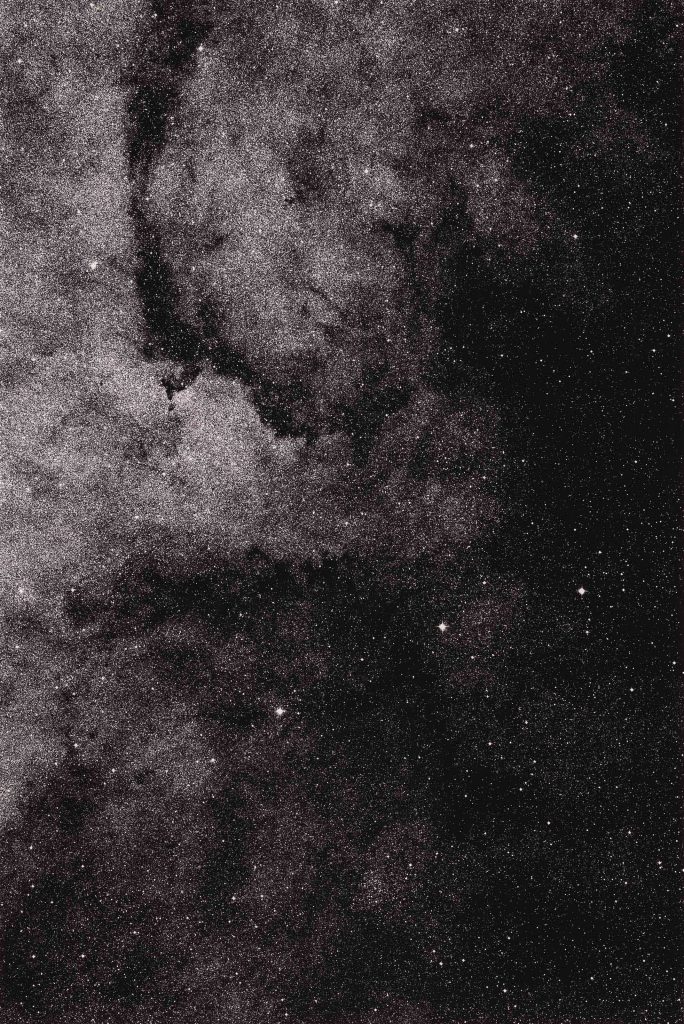Thomas Ruff, The Little Prince of Stars
12.11.2017Thomas Ruff, The Little Prince of Stars, by Elodie Morel
For those who love to scour the skies looking for the protean work of a mysterious creator amongst the stars, Thomas Ruff imposes and reveals the bareness of our starry nights in oversized prints, placing his work at the crux of fantastical concept and popular realism. This huge starry void engages us and draws us in; a fascinating thousand-year-old mystery experienced every time we gaze up at a sky strewn with stars. To look at Thomas Ruff’s work is to come face to face with this darkness in order to understand it, without fearing the unknown. Exploring the obscurity of a galaxy that is partially, and intentionally, fragmented by the artist switches on the brain as we open ourselves up to the magic of the night.
Thomas Ruff’s work is a continuation of ‘Objective German Photography’ initiated by Bernd and Hilla Becher at the tail end of the Sixties, and lectures at the Kunstakademie in Düsseldforf from 1977 to 1985. It was here that he rubbed shoulders with other students and future big shots in photography such as Andreas Gursky, Thomas Struth and Candida Höfer, all of whom were studying at the School of Photography in Düsseldorf. The foundations of this movement were directly opposed to the prevailing view after the Second World War that favoured a more humanist photograph of the « decisive moment ». Photography at the School in Düsseldorf leaned more towards a precise protocol involving neutral light, frontal framing techniques and no background. The Bechers travelled around Germany compiling a detailed inventory of the tools used to create photography that was perfectly objective, totally neutral and devoid of any emotion or empathic elements.
Thomas Ruff did not escape this trend and began an initial series of frontal portraits of his friends in the Eighties. Shots taken at eye level with no psychological input to fall in line with the required distancing advocated by the Bechers. In contrast to the standard formats of the time, Thomas Ruff’s photos were huge, over 2 metres, for a surprisingly direct confrontation with the viewer.
This piece of work questioned the very essence of the role of photography and its power of representation. By introducing distance and using digital retouching techniques, Thomas Ruff cancelled out any resemblance to reality and broke with the traditionally more emotional representation of the subject.
The essence of Thomas Ruff’s work is to confront fields of experimentation and representation. Technique and science are the focus of his preoccupations and nothing is more evident in his series called « Stars » created between 1989 and 1992, when he used archive images from the Southern Europe Observatory based in Chile that had been taken using high-end optics at the end of Seventies. As a child he had toyed with the idea of being an astronaut or a photographer, so Thomas Ruff was quick to realise that the tools he had at his disposal were neither powerful enough nor sophisticated enough to obtain the images of the stars he was after. Some of his influences include writings about photography by the German philosopher Vilém Flusser (Philosophy of Photography) that viewed photography as the most important invention after writing, as well as images of plants taken and used by Karl Blossfeldt in the Twenties to explain architectural concepts to his students. A work of artistic appropriation that would always be at the centre of his creative process.
Thomas Ruff sorted his images into different categories: the Milky Way; interstellar medium (ISM); high density stars and distant stars. He selected certain details and deliberately exaggerated them, naming the images by using their spatial coordinates only. By approaching his subject matter in a purely scientific and objective way, the artist managed to create a totally new piece of work from a resolutely personal aesthetic. A large piece of paper demonstrates the incandescence that dots the darkness of the night; stars that have disappeared for millennia, and whose only trace of light has managed to be captured by the camera lens. Thomas Ruff has taken up a theme beloved of German Romanticism, but he is also advocating the distancing of the artist and the ‘ready-mades’ of Marcel Duchamp (the latter was known for elevating the object from normal to art status). He forced the viewer to see an unequivocal reality, a portrait of light and time. At the frontier between a dream world and science, Thomas Ruff fragments the night sky, orders the constellations and immobilises stars. Traces of light on paper; a vision of forgotten space; a portrait of the elusive and work on an abyss, where the art of creation becomes the power of narration without words.
Elodie Morel is Director of Sales at Christie’s Paris.


